Right Hand Fingers & Thumb on the Boot Joint
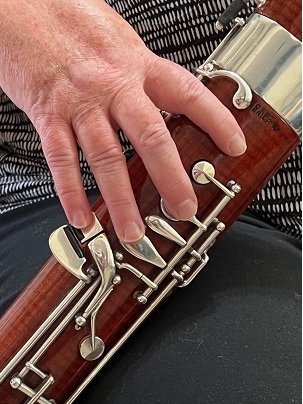
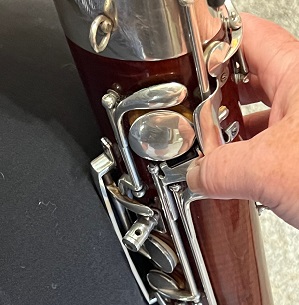
B A G and low F
These notes are played by both hands. The left-hand fingers and thumb will stay in the “C” position while the right-hand fingers move.
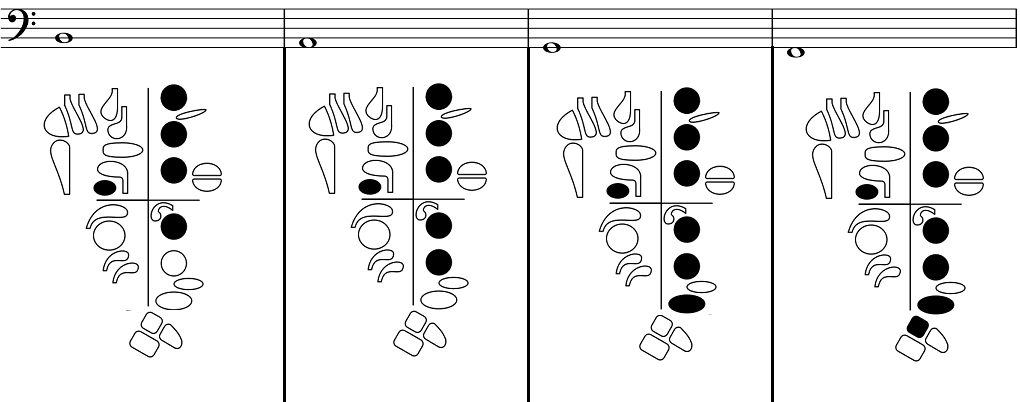
The B and A tone holes on the front of the boot joint are covered by the index (B) and middle (A) fingers of the right hand. The G key is operated by the ring finger on the right hand, and the low F key is operated by the right-hand pinky.
Tip: These notes require moving only one finger between each note. Keep your fingers soft and light. The harder you squeeze or press with your fingers, the harder it will be to move them. Make sure you are not trying to hold the bassoon up with your fingers. Let the weight of the bassoon be supported by the seat strap and your right thigh.
Air & Ear Reminders:
- Use your AIR.
- Use your EAR. Give yourself an aural target by playing with a reference tone (ex. www.tuningdrones.com). Choose an octave B drone to start and then work with a perfect fifth of B and F-sharp.
- Articulate each note by lightly tapping the front of your tongue against the reed at the start of each note.

Once you feel comfortable playing B with the reference tone, play the exercise below. Work on keeping your right-hand index finger close to the hole when you lift it to move back to C after playing B. Keep counting as you play.

Play Matching Pitch on A. Focus on response and tuning.

Once you feel comfortable playing A with the reference tone, continue to the next exercise below. Keep your fingers close to the tone holes when they are not in use and be sure to count each beat in your head as you play.

Play Matching Pitch on G and on F. Continue to focus on response and tuning.
Once you feel comfortable playing G and F with the reference tone, continue to the next exercise. Don’t forget to keep counting!
TROUBLESHOOTING:
If you have trouble with these notes sounding too high (not in the proper octave), here are some suggestions to help:
- Hear the pitch accurately (in the proper octave).
- Make sure your left thumb is on the whisper key and press it all the way down.
- Make sure the whisper-key pad is fully covering the pinhole on the bocal nub.
- Soften the hug with your lips around the reed.
- Add space between your teeth and open your oral cavity (“Hot Pizza Mouth”)
- Make sure you are not pushing up on the reed with your bottom lip.
- Blow warmer air.
- If these suggestions don’t work, the problem is probably with the reed. Watch the video on “Adjusting the Tip Opening” in chapter 89 Simple Reed Adjustments.
Now you are ready to play some tunes using these four notes.
REMINDER:
- Use your AIR (blow steady air)
- Use your EARS to aim the pitch of each note (hear the tune in your head as you play).
- Articulate each note.
- Count four beats per bar during Right Hand Tune, and two beats per bar during Lightly Row.

Lightly Row in G
Count the eighth notes for this tune to keep the tempo nice and steady. Each quarter note is subdivided (broken down) into 2 equal length eighth notes. There are two ways to count the eighth notes. You can either give each eighth note a number and count to four in every bar, or you can use numbers for the eighth notes that fall on the beat and the word “and” (shown with a plus sign) for the second eighth note on every beat. Feeling and counting the smaller note values is called subdividing and it helps keep the tempo steady.

Are You Sleeping?

Folk Song
This tune does not start on the downbeat. Notice that the first bar only has one beat worth of notes. When a piece begins on the beat BEFORE the downbeat, we say it starts on the upbeat.
When you are ready to begin, count the first three beats silently to yourself to set the tempo. Inhale as you count the first two silent beats and set your embouchure and fingers on beat 3.

Morning Mood from Peer Gynt Suite
There are 3 beats per bar and the quarter note gets the beat. Subdivide the quarters into eighth notes in bars 10 and 12. Keep counting during the longer notes.
This tune has a lot of slurs. A slur is similar to a tie. It is a way of connecting notes into a group. The tie is used to connect notes on the same pitch; and the slur is used to connect notes on different pitches. Articulate only the first note of each slurred group of notes. In Morning Mood articulate the first C and blow a steady stream of air as you play the next five notes. Articulate the C on the downbeat of bar 3, the first C in bar 5, the first D in bar 6, and the C in bar 7. Changing notes without articulating requires coordination of the fingers in order to avoid “blips” between the printed pitches.
Practice Tip:
Practice slurred passages by adding articulation to check coordination of your fingers. Practice articulated passages slurred to make sure you are blowing a steady airstream.
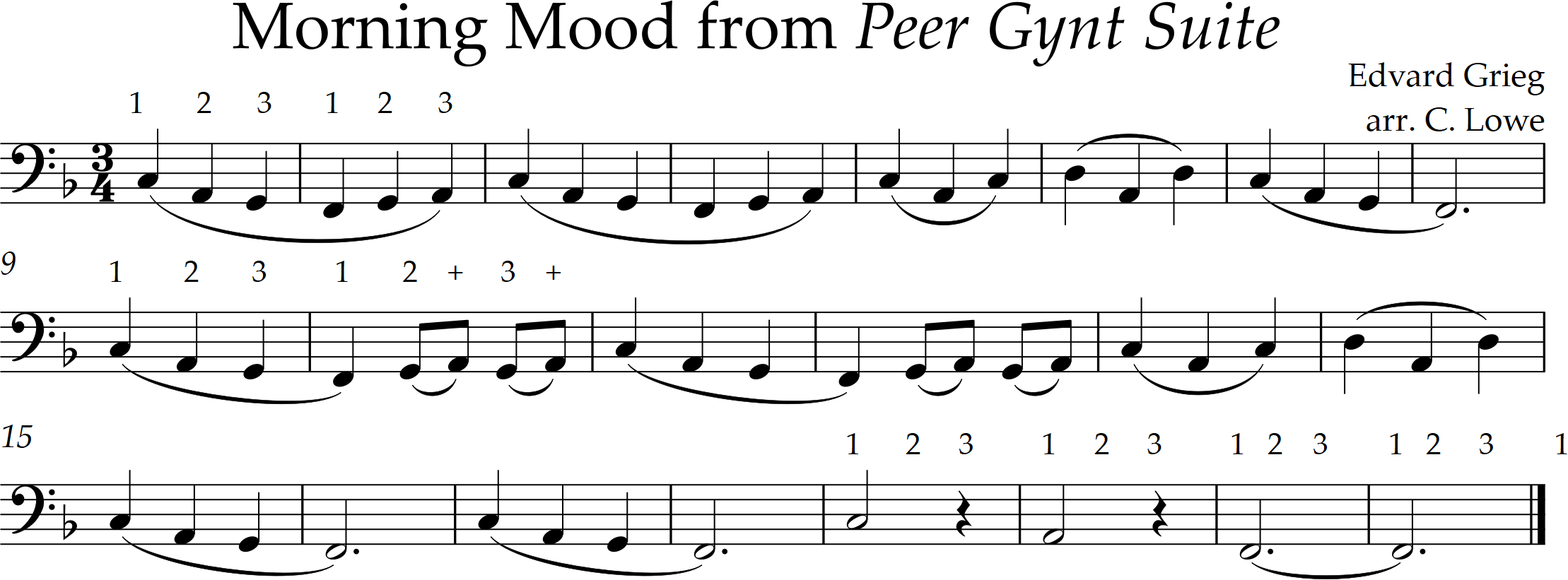
TIP: Practicing scales with a drone is a terrific way to develop your active listening skills for good intonation.
Play the C scale with a C-G drone.

There is one more note to learn before playing Menuet du Tambourin by Jacques Hotteterre. That note, low f-sharp (f#) is covered in the next lesson. But, there are sections you can play through now because the notes are from the C major scale you just learned.
Excerpts from Menuet du Tambourin by Jacques Hotteterre
(NYSSMA Level One solo with piano)
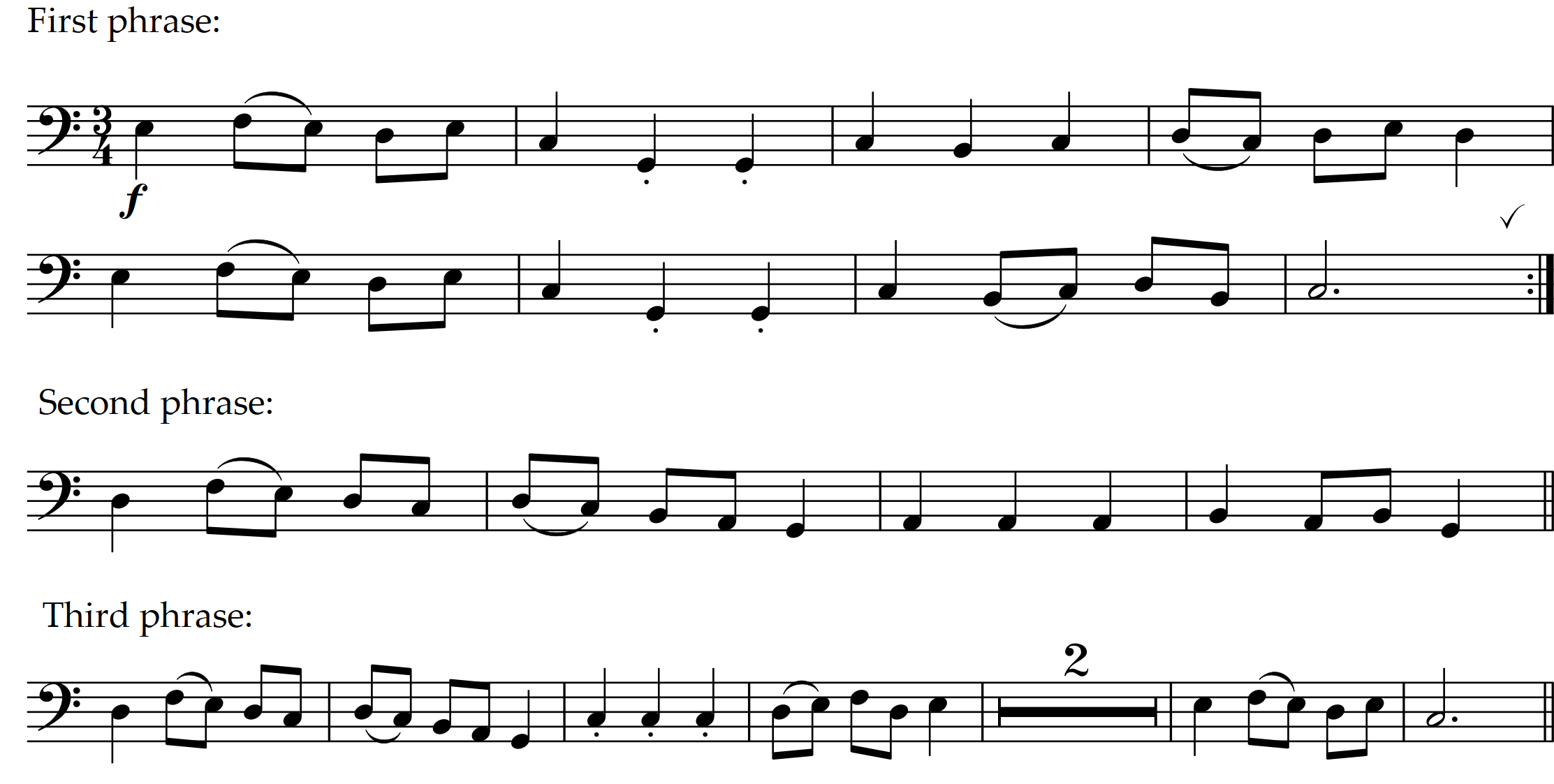



Feedback/Errata